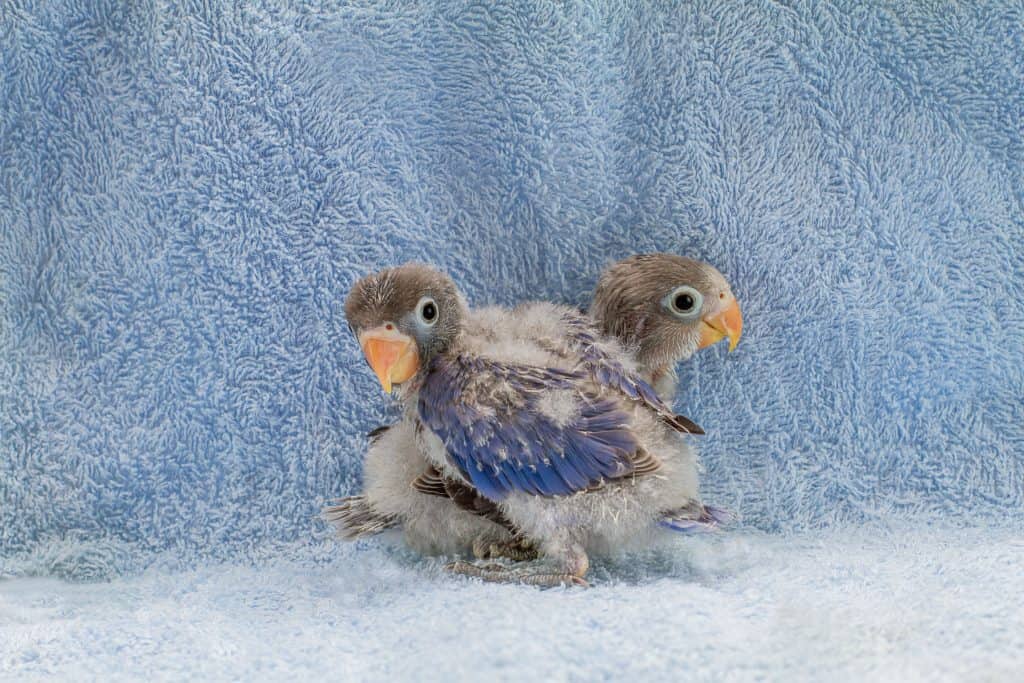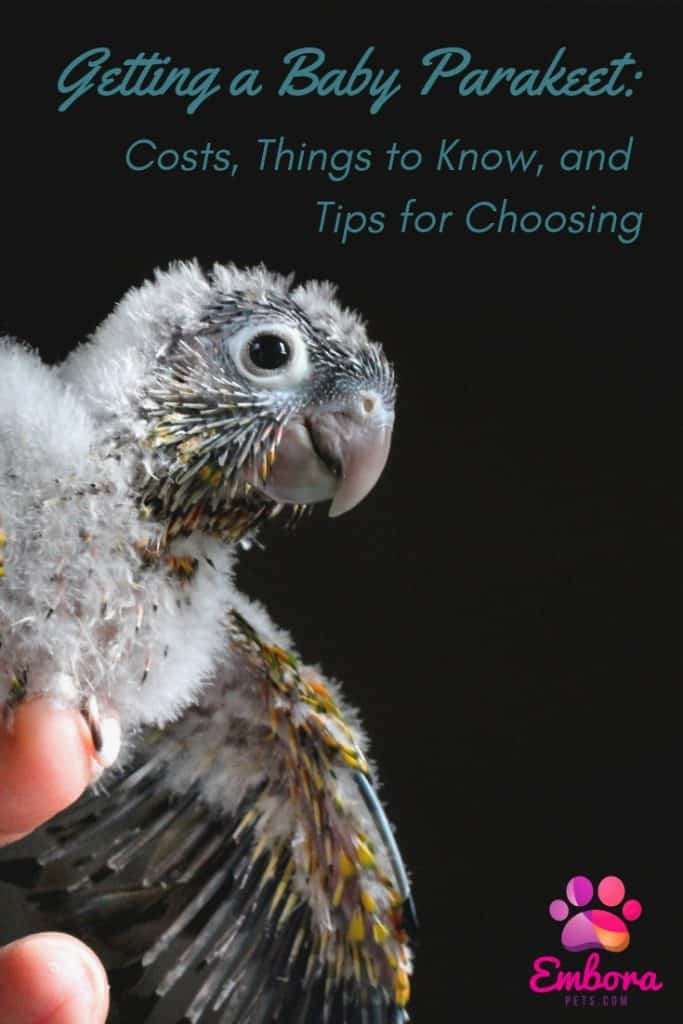Getting a Baby Parakeet: Costs, Things to Know, and Tips for Choosing

Parakeets are great pets for first-time bird owners. They are relatively easy to care for, cute, and smart! But during their different stages of life, they will have different needs. Let’s talk about getting a baby parakeet.
What do you need to know about buying a baby parakeet?
Baby parakeets are simple birds who do not need too much. They cost anywhere from $20 to $60 dollars. Owners should teach them tricks and play with them to bond and build a relationship. Do NOT use harsh chemicals around them. In regards to food, they can eat a variety of seeds, fruits, and vegetables.
What is the Cost of a Baby Parakeet?
| Store | Price |
| PetSmart | $23.99 |
| BirdsNow | ~$25 |
| Birdbreeders.com | $90 |
| A Bird Breeder | ~$20 – $60 |
Baby Parakeets (or Budgies) generally cost anywhere between $20 to $60. This is the price range you should expect to see wherever you look. Baby parakeets that cost more than $60 are probably overpriced. You should also be wary of birds that are too cheap though because this could signify that the bird is unhealthy.
All things considered though, the price you pay for these little guys is not that bad. These birds usually live for about 12 to 15 years if you keep them healthy.
How to Take Care of Baby Parakeets
Parakeets or “Budgies” (short for Budgerigars) are really great birds to have as pets. The specific, petite variety that people buy are originally from Australia.
To be quite honest, parakeets are simple animals. They do not require much, only that you do not harm them. Feed them and make sure that they do not get sick. Check for discharge around their eyes and nose. This can tell you a lot about their health.
Baby parakeets are not completely used to their surroundings at first. They may be a bit disoriented or clumsy but things will sort themselves out.
When it comes to food, give them seeds or pellets with a mix of vegetables and fruits. They may prefer one over the other. One thing I would suggest is asking the store or the breeder what the bird’s diet was while they had it. Feed it whatever they fed it to keep their diet consistent at first. If you want to make changes, do it gradually so that you don’t get your little bird sick.
If you’re looking for advice from a community of parakeet owners, this thread on Reddit has some great info on how to take care of a baby parakeet.
What Should I NOT Do?
1. Roughhouse
It is totally within your bounds to play some games with your bird or teach it tricks but be very careful that you do not go too far. These are tiny birds and it is very easy to accidentally abuse them. I do not think that many adults will have this problem, but many children won’t know the limits on how much they can play with parakeets.
Adult supervision should always be present when children are near the bird. Even if the kids mean well, they can end up hurting pets by accident. Keep an eye on them to make sure that things don’t go too far.
2. Smoke
Do not smoke in your house with the bird. If you want to get away from the smoke, you always have the option of leaving for
Second-hand smoke has bad health effects on people already, and these problems can get much worse for the birds who are much smaller than us. A regular dose of smoke-filled rooms and environments can lead your parakeet to have pneumonia, conjunctivitis, bacterial infections, and even cancer.
Go outside and smoke if you have to. Make sure you also dispose of cigarette butts properly, because your bird might be tempted to eat or play with them. If they ingest any part of a cigarette, they can easily get nicotine poisoning.
3. Have a Big Party
This goes back to the whole supervision thing. People get drunk and they might do something stupid to your bird or feed it something that it should never be fed.
During a party, it is impossible to keep track of your bird the whole time and still enjoy the party. The birdcage might even be knocked over. There are plenty of things that could happen.
Personally I put my bird in a different room and lock the door when I have parties. That way the bird is not making a bunch of noise and people do not bother it.
4. Use Powerful Cleaning Chemicals
Sometimes you just get in the mood to clean. Nobody knows where these urges come from. It just happens. But if you have a bird, you would be wise to put them in a different area while cleaning.
When you clean, it will leave the powerful chemicals lingering in the air. Insecticides, bleach, oven cleaners, etc. Your bird can get EXTREMELY ill from these chemicals.
Here are a couple of things you can do to make it easier for your bird:
- Open your windows to ventilate.
- Wipe down any residue from the chemicals on the walls, floor, etc.
- There are bird-friendly cleaning supplies at bird shops that you can buy.
- You can even use homemade cleaning supplies, such as vinegar, which are far less harmful to your bird.
Another risk you need to be aware of when cleaning is the self-clean function that many ovens use. These are very convenient for us, but they can be extremely harmful to your pet birds.
The self-cleaning ovens have Teflon in them and when that heats up, it releases chemicals that can kill your bird. If you use the self-clean button, keep as many windows open as possible so the air can be ventilated.
5. Spray Hair Products

I know that having your bird around in the house is fun. It tags along whenever you goPlease and that ‘s fun for many owners. However, you
This is in a similar vein with the cleaning one. Move your bird to a different area of the house when you get ready in the morning.
6. Swear
Your parakeet will pick up things that you say frequently and can learn to repeat them. However, these birds don’t really understand language,
You could argue that parakeets will not always pick up on the swear words but generally, these birds will learn words that have been given extra emotion and emphasis. In a lot of cases, these words might be ones you don’t want it to repeat in mixed company!
Who Should I Buy a Baby Parakeet From?
You can buy a bird from a pet store. Most big pet stores always have a selection of birds, and they’re almost
How do you know if the breeder is good?
- They care about their birds. They will not let you have the bird until it has been properly weaned off of its parents.
- The previous home of the bird is clean and in good condition. You can tell how well the bird has been treated by looking at the state of its living conditions.
- The seller answers your questions honestly and will not shy away from any difficult questions that come.
- They can provide a written guarantee of the health of the bird. You can either ask for it or they give it to you. This paper should allow you to return the bird if you discover preexisting health problems in the bird.
Get an Avian Veterinarian
Birds are different from most animals, so they will need a vet that has specialized in caring for them. Veterinarians are really helpful and good but most do not know much about birds. Make sure that your chosen vet has the experience that they need to help you.
This level of specification might end up costing you a bit more. It depends on the vet and the level of medical care that your parakeet requires. I would recommend it though if your bird is really struggling and you do not know what to do.
Best Ideas for Their Cage
Of course, you will need a cage for the little bird. I would suggest that the minimum size should be no smaller than 14″ long by 11″ wide by 12″ high. This might be weird to you because the bird is tiny. However, your bird will be much happier with something that has space that is much bigger than itself.
This is especially true for young birds. They will want space to explore, move around, and play in.
Another thing is you want to check is that the spacing between the cage bis are smaller than half an inch. That way your little bird does not get its head stuck. The cage should be a comfortable space for them to live
Look for cages that are made of heavy wire. They are much less likely to bend or break. A cage with a non-toxic coating is preferable. This makes rust less likely to happen.
For the cage, I would suggest the Prevue line of cages. These are really high quality. They fit all the qualities I listed above and are perfect for parakeets to live in. Many customers have also
I would suggest this Prevue Flight Cage for starters. It is simple, but also bigger than the minimum size. It has a nice big door to slip your baby parakeet in and out to show friends and family. It comes with two cups and wood perches. This is a good starter cage that you can eventually upgrade to something more.
I would suggest buying more cups for your bird than the two that come with it. The two that come with the cage are for food and water. You will usually want another for fresh fruit and the occasional treat.
Cages come with dowels for the bird to perch on. Perching is actually very important for birds because it provides some exercise and helps with their foot health. You will want to buy other perches with natural bends and angles.
Variety is the name of the game when it comes to perches. Getting more irregular shapes that are more natural looking are healthy for birds as well. I would remove one of the bigger dowels on the cage because honestly, the dowels are not ideal for your bird.
Setting the perches at different levels gives variety to the life of your bird. The more variety you have, the more your bird will be entertained and satisfied. That being said, do not overload the cage with tons and tons of perches. Your little friend will still want to have o
What Do They Eat?

There are many different options and diet mixes for your parakeet to eat. To start off with, I would suggest feeding it whatever they were
This is another reason why I suggest getting your parakeet from a breeder. You can get more specific and personallized answers from them than you could get from a store.
Some birds mainly eat seeds while others eat pellets. Ask whoever you got the bird from what they specifically feed the bird. They might even feed the baby parakeet fruits and vegetables.
When people think of feeding small birds, they think of bird seeds. This is good for the animal’s diet because it contains vitamins and minerals, but it’s not the only thing they need. Just like humans, birds need a variety of nutrients, and they need to get
Many types of bird seed also have a high-fat content. This is good for part of their diet, but they need more than this. You’ll want to add fruits and vegetables to balance everything out.
Fruits and Veggies
Picking a diet for your budgie’s is important to a happy bird!
Another option is to buy dried fruits. You could even dehydrate these foods yourself if you are so inclined. Make sure that the food is dried naturally. Trail mix is also a great option for your parakeet. It is packed full of nutrients and they’ll find it tasty too! Just make sure you remove all chocolate and any chemically processed nuts.
If you feed your bird dried fruit, make sure that it doesn’t include any sulfur dioxide. That will increase the aggressiveness of your bird along with making it more hyperactive.
A fun idea is warming up the food you give them.
I really like to give my birds grapes and blackberries. I find that the small fruits are easy to give to them and it is just the right size for them to handle without me having to do anything.
Proteins
Bird in the wild get their protein from insects but these are domestic birds so we have to modify that a little. You do not need to feed them a lot of protein. Only give them a small nibble of fresh protein every couple of weeks. They can snack on peanuts and other nuts to get a little protein in.
The kinds of fresh protein I am talking about is tuna, hard boiled eggs or chicken cooked
A Note of Caution
There are a lot of things that you can feed your parakeet but there are some foods that are dangerous or even deadly for a parakeet to eat.
Do not under any circumstance feed your bird pits from fruits. The specific ones I am talking about are the cherry and peach pits. They have chemicals that are poisonous to parakeets. Apple seeds are also dangerous for birds to eat, and avocados can end up poisoning your bird.
To be safe, always do some research on the food that you give to your bird. Even if it’s harmless to us, it can be dealy for them.
What Kind of Temperament Do Baby Parakeets Have?
Parakeets are one of the most cheerful animals to take care of. They really do not get bothered by much. Because of their sweet disposition and even-tempered personality, many people enjoy them. I personally find them easy to take care of. Feed them, play a few games with them, and clean up after them. They are not much of a hassle.
Since they’re such tiny birds, they do not demand much. They do not really need a whole lot of space to move around. They don’t even fly that much
They are social creatures so they work well with other parakeets. If you are patient, you can grow a great bond with your bird. They can become pretty loyal and will probably enjoy spending time perching on your finger or shoulder.
As with any pet, you will want adult supervision when kids are around. Because of their tiny size, baby and adult parakeets can easily become victim to children who are are not tactful with animals. Parakeets aren’t very good at fighting back, but they can give a good peck or bite when they feel threatened.
Do Baby Parakeets Form Relationships?
Parakeets will form relationships and those are better started when young. They are flock birds, which just means they will form an attachment with whoever or whatever they see the most. If you want the bird to be more interactive you, either do not buy other birds or keep them in separate cages.
You want to be your bird’s “flock.” So decide beforehand how interactive you want to be with your bird. Teaching tricks to your parakeet will also strengthen your bond. The more time you spend with your bird, the more comfortable it will become with you.
Can You Teach a Baby Parakeet Tricks?

Yes, a parakeet can be taught tricks. The main one that comes to mind is teaching it to talk. Once your bird becomes comfortable with you, you should be able to start teaching it some simple tricks.
Besides the tricks that I provide, there are tricks at Omlet which you could use.
1. Step Up
One of the first things you would want to teach your parakeet is how to step up into your hand. This one is not so much of a trick but more of a way to develop a personal relationship with your bird.
You teach your bird to do this by putting your finger up to the cage point out like a perch. As you talk to your bird and calmly wait, it will understand what to do because your finger is acting like a perch.
If your bird is not taking to your finger, then each day try a couple of times putting your finger near the cage ready to take the bird and do this until it does not flinch or scoot away as a reaction.
When it stops reacting defensively, put your finger in the cage and see what it does. They’ll become more comfortable with this proximity and will start to
You could even teach it to get on your finger by saying “step up!” or any phrase that works for you. Try to keep the volume and tone of your voice consistent as you say
2. Stick Trick
A lot of tricks just involve an action to get a treat. It is a classic Pavlov situation. The stick trick is no exception to this. You can you pretty anything that could be a stick. A twig or dowel works just fine. Put the stick closely in front of the parakeet and let them examine it for a minute until they realize that it is not a threat.
Once the bird has become best friends with this stick, teach it to nibble on it by giving it a command. Make it specific to the trick. Once it does it, give it a treat. This reinforces the behavior (I told you it was classic Pavlov) and they will soon have this trick down in no time.
3. Soccer Trick
Parakeets are smart cookies. If you roll a ball in front of them, they will try to stop it with their head. So why not make a little game of soccer out of it? You could create your own net or find a miniature one somewhere. Place it behind the bird and then flick a tiny, lightweight ball towards them and watch it stop the ball.
If they do block it, interact with them and say, “Good block!” or something to that effect. You could even switch it around and teach the parakeet to roll the ball into the goal which then you could shout an emphatic, “GOAL!!”
4. Talking
Teaching your parakeet to talk sounds difficult. It really is about patience. Are you ready for the best way to teach them to talk? Well, just talk to them. They listen and are smart enough to pick up what you are saying. Most birds do respond to a request or a question.
Talking to them is the most constant and effective way to teach them. Start out simple with words like “hello” and “goodbye.” Teach it other things like “thank you” when giving it food. Eventually, move onto other things like people and requests.
This is arguably the most amazing “trick” a parakeet can perform. Parakeets are one of the most intelligent birds out there. Take advantage of that and teach them a few tricks!
What Kinds of Colors are Parakeets?
Parakeets come in many different colors. There are many colors because of gene mutation. The main color is a yellow/green look. All others are color mutations. The most common color mutation is a blue/white which is basically just a budgie who lost its yellow pigment. These are the two main kinds of colors.
People breed mutations together to get new colors and styles which makes buying them fun. There is a whole science behind color/gene mutation that I highly suggest looking up. It is very interesting and it can help you find a color of bird you are looking for.
Related Questions
Do budgie bites hurt?
A bite from a budgie does not hurt very much at all. Their beaks are actually not strong enough to break skin. It is kind of a shock when you are not expecting it. If they feel threatened they will bite.
Do parakeets die easily?
Your parakeet most likely will not die unless you neglect it. Just feed your bird and provide plenty of water so it won’t starve or dehydrate. Also, do not use harsh chemicals around it like hairspray or most cleaning supplies.
Why do budgies scream?
Parakeets will scream when they’re bored, sick, or injured. Sometimes they are just excited. It is random and weird but you will probably get used to it. Sometimes when you leave for a while, they will scream to get your attention.

